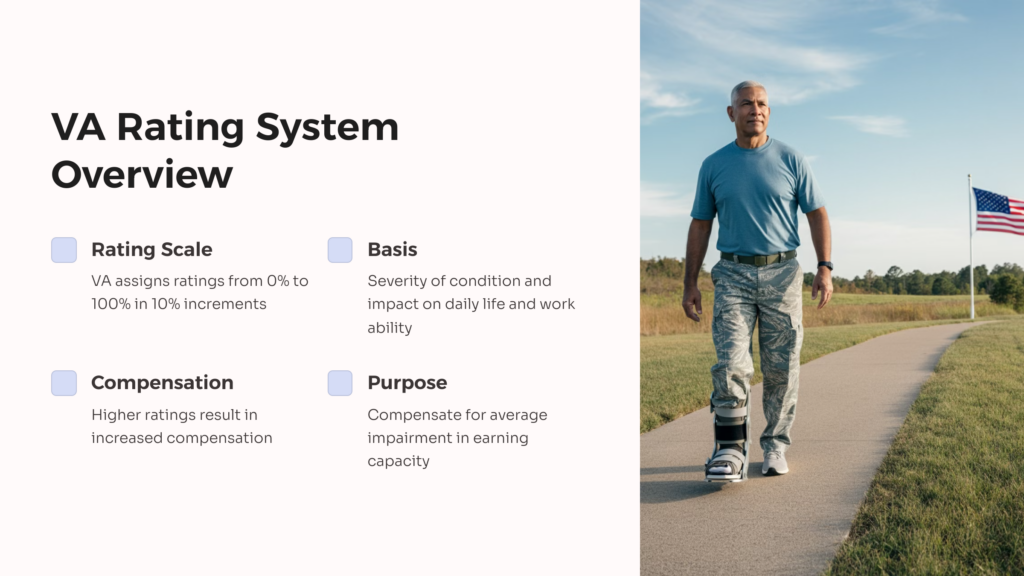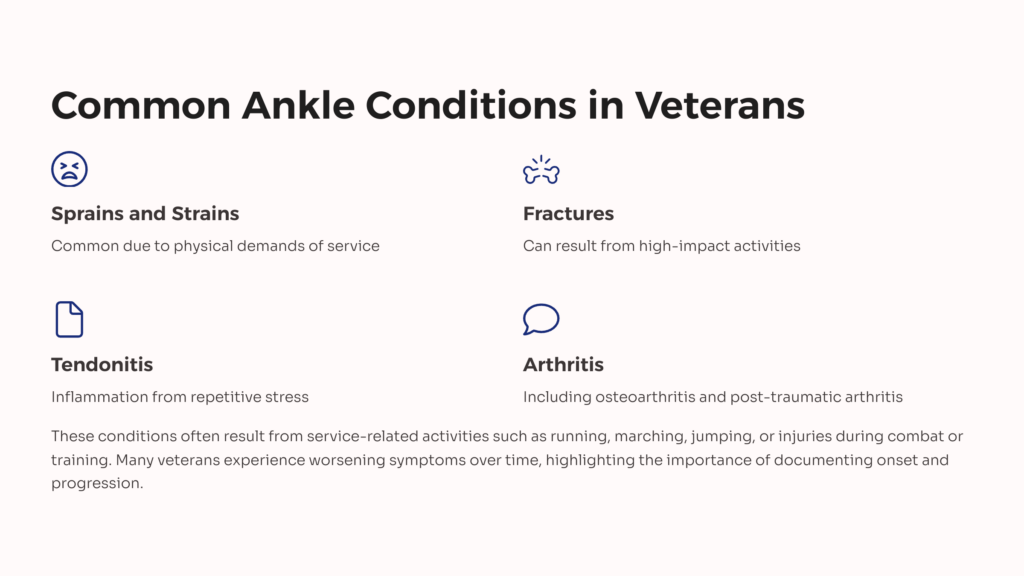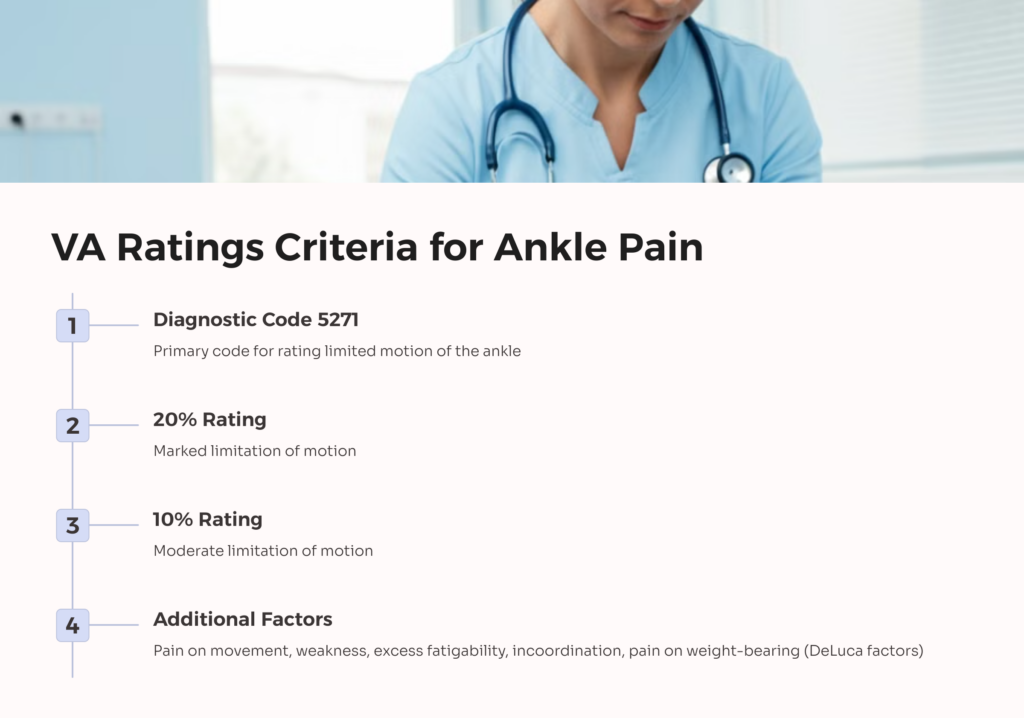The Department of Veterans Affairs (VA) uses a rating system to determine the level of disability compensation for veterans with service-connected conditions. This system is crucial for veterans suffering from ankle pain and instability. The VA assigns ratings from 0% to 100% in 10% increments, based on the severity of the condition and its impact on the veteran’s daily life and ability to work.

For ankle conditions, the VA primarily uses the musculoskeletal system section of the VA Schedule for Rating Disabilities (VASRD). This schedule provides specific criteria for various ankle conditions, including pain, limited motion, and instability. The higher the rating, the more compensation a veteran receives.
It’s important to note that the VA rating system is designed to compensate veterans for the average impairment in earning capacity resulting from their service-connected disabilities. This means that even if a veteran can work, they may still be eligible for compensation if their ankle condition impacts their earning potential.
Common Ankle Conditions Affecting Veterans

Veterans often experience a range of ankle conditions due to the physical demands of military service. Some of the most common ankle conditions include:
1. Ankle sprains and strains
2. Ankle fractures
3. Tendonitis (inflammation of the tendons)
4. Arthritis (osteoarthritis and post-traumatic arthritis)
5. Ankle instability
6. Achilles tendon injuries
These conditions can result from various service-related activities, such as running, marching, jumping, or injuries sustained during combat or training exercises. For example, a veteran who repeatedly sprained their ankle during airborne training may develop chronic ankle instability later in life.
Many veterans find that their ankle conditions worsen over time, even after leaving the service. This progression can lead to increased pain, decreased mobility, and a significant impact on quality of life. It’s crucial for veterans to document the onset and progression of their ankle conditions to establish service connection and receive appropriate VA benefits.
Criteria for VA Ratings of Ankle Pain

The VA uses specific criteria to rate ankle pain and associated conditions. The primary diagnostic code for ankle conditions is 5271, which rates limited motion of the ankle. Here’s a breakdown of the ratings:
- 20%: Marked limitation of motion
- 10%: Moderate limitation of motion
To determine the level of limitation, VA examiners compare the veteran’s range of motion to the normal range. Normal ankle dorsiflexion is from 0 to 20 degrees, and normal plantar flexion is from 0 to 45 degrees.
However, ankle pain is not just about range of motion. The VA also considers:
- Pain on movement
- Weakness
- Excess fatigability
- Incoordination
- Pain on weight-bearing
These factors, known as DeLuca factors (named after a court case), can increase a veteran’s rating if they cause additional functional loss. For example, a veteran with moderate limitation of motion might receive a 20% rating instead of 10% if they experience severe pain that further limits their ability to use the ankle.
It’s crucial for veterans to clearly communicate all symptoms and limitations during their VA examinations to ensure an accurate rating.
Understanding Ankle Instability Ratings
Ankle instability is a common problem for veterans, often resulting from repeated sprains or injuries during service. The VA doesn’t have a specific diagnostic code for ankle instability, but it can be rated under several codes:
- Diagnostic Code 5262 (impairment of tibia and fibula)
- Diagnostic Code 5284 (other foot injuries)
Under DC 5262, ratings are as follows:
- 40%: Nonunion of tibia and fibula, with loose motion, requiring brace
- 30%: Malunion with marked ankle disability
- 20%: Malunion with moderate ankle disability
- 10%: Malunion with slight ankle disability
For DC 5284, the ratings are:
- 30%: Severe foot injury
- 20%: Moderately severe foot injury
- 10%: Moderate foot injury
Ankle instability can significantly impact a veteran’s daily life, causing frequent falls, difficulty walking on uneven surfaces, and the need for assistive devices like braces or canes. When filing a claim for ankle instability, veterans should provide detailed descriptions of how the condition affects their mobility and ability to perform daily activities.
It’s worth noting that in some cases, veterans may be eligible for separate ratings for ankle pain and instability if the symptoms don’t overlap. This approach, known as pyramiding, is generally not allowed, but exceptions can be made when distinct symptoms are present.
Arthritis and Ankle Pain: VA Ratings Explained
Arthritis is a common cause of ankle pain in veterans, often developing years after an initial injury or due to the cumulative stress of military service. The VA rates arthritis under two main diagnostic codes:
1. Diagnostic Code 5003 (degenerative arthritis)
2. Diagnostic Code 5009 (arthritis, other types)
For degenerative arthritis (osteoarthritis), the ratings are based on X-ray evidence and limitation of motion:
- 20%: X-ray evidence of involvement of 2 or more major joints or 2 or more minor joint groups, with occasional incapacitating exacerbations
- 10%: X-ray evidence of involvement of 2 or more major joints or 2 or more minor joint groups
However, if the limitation of motion is compensable under another diagnostic code (such as DC 5271 for the ankle), the veteran will be rated under that code instead.
For other types of arthritis, such as rheumatoid arthritis or post-traumatic arthritis, the VA uses a different rating scale based on the frequency and severity of incapacitating episodes. These ratings can go up to 100% for severe, systemic involvement.
It’s important for veterans with ankle arthritis to provide medical evidence, including X-rays and detailed descriptions of how the condition impacts their daily life. This information can help secure a higher rating and more accurately reflect the veteran’s level of disability.
Filing a VA Claim for Ankle Pain

Filing a VA claim for ankle pain requires careful preparation and documentation. Here are the key steps:
1. Gather evidence: Collect all medical records related to your ankle condition, including service treatment records, private medical records, and VA treatment records.
2. Obtain a current diagnosis: Ensure you have a clear, current diagnosis of your ankle condition from a medical professional.
3. Establish service connection: Provide evidence that links your current ankle condition to your military service. This could be direct (injury during service) or secondary (caused by another service-connected condition).
4. Complete VA Form 21-526EZ: This is the application for disability compensation and related compensation benefits.
5. Submit supporting statements: Include statements from family, friends, or fellow service members who can attest to your ankle condition and its impact on your life.
6. Consider a Nexus Letter: A medical opinion from a doctor explaining how your ankle condition is related to your military service can strengthen your claim.
Remember, the key to a successful claim is providing comprehensive evidence that clearly shows the severity of your condition and its connection to your military service. Don’t hesitate to seek help from a Veterans Service Organization (VSO) or a VA-accredited attorney if you need assistance with your claim.
The Appeals Process for VA Ankle Pain Claims
If your initial claim for ankle pain is denied or you receive a lower rating than expected, you have the right to appeal. The appeals process can be complex, but understanding it can help you navigate it more effectively:
1. File a Notice of Disagreement (NOD): This must be done within one year of receiving your rating decision.
2. Statement of the Case (SOC): After receiving your NOD, the VA will review your case and issue an SOC explaining their decision.
3. VA Form 9: If you disagree with the SOC, you can file a VA Form 9 to continue your appeal to the Board of Veterans’ Appeals (BVA).
4. BVA Hearing: You can request a hearing with a Veterans Law Judge to present your case.
5. BVA Decision: The BVA will issue a decision to grant, deny, or remand (send back for further review) your claim.
6. Further Appeals: If you disagree with the BVA decision, you can appeal to the U.S. Court of Appeals for Veterans Claims.
Throughout this process, it’s crucial to meet all deadlines and provide any additional evidence that supports your claim. Many veterans find it helpful to work with a VSO or attorney during the appeals process to ensure they’re presenting the strongest possible case.
Secondary Conditions Linked to Ankle Pain
Ankle pain and instability can often lead to secondary conditions that may also be eligible for VA disability compensation. Some common secondary conditions include:
1. Knee problems: Ankle issues can alter your gait, putting extra stress on your knees.
2. Hip pain: Compensating for ankle pain can lead to hip misalignment and pain.
3. Lower back pain: Changes in walking patterns due to ankle pain can strain the lower back.
4. Depression and anxiety: Chronic pain and reduced mobility can impact mental health.
5. Weight gain: Difficulty exercising due to ankle pain can lead to weight gain, which can exacerbate other health issues.
When filing a claim for a secondary condition, it’s important to provide medical evidence that clearly links the new condition to your service-connected ankle disability. A medical opinion or nexus letter from your doctor can be particularly helpful in establishing this connection.
Remember, secondary service connection can significantly increase your overall disability rating and compensation. Don’t overlook these related conditions when assessing the full impact of your ankle disability.
Tips for Securing a Higher VA Rating
Securing an appropriate VA rating for your ankle pain can be challenging. Here are some tips to help you get the rating you deserve:
1. Be thorough in your C&P exam: Clearly communicate all your symptoms and how they impact your daily life. Don’t downplay your pain or limitations.
2. Keep a pain journal: Document your daily pain levels, activities you can’t perform, and how your ankle condition affects your work and personal life.
3. Get buddy statements: Statements from people who know you well can provide valuable insight into how your condition affects you.
4. Seek regular medical treatment: Consistent medical records provide strong evidence of the severity and progression of your condition.
5. Consider getting an Independent Medical Opinion: If you disagree with the VA’s assessment, an independent medical opinion can provide a different perspective.
6. Understand the rating criteria: Knowing what the VA looks for can help you communicate your symptoms more effectively.
7. Don’t ignore flare-ups: Make sure to report and document any periods when your symptoms are worse than usual.
8. Consider the impact on employability: If your ankle condition significantly impacts your ability to work, you may be eligible for Total Disability based on Individual Unemployability (TDIU).
Remember, the goal is to paint a clear, accurate picture of how your ankle condition affects your life. Don’t be afraid to advocate for yourself and seek help when needed.
Frequently Asked Questions on VA Ankle Pain Ratings
1. Q: Can I get a rating higher than 20% for ankle limitation of motion?
A: The 20% rating under DC 5271 is the maximum for limitation of motion. However, you may be eligible for a higher rating under different codes if you have additional symptoms or complications.
2. Q: How does the VA measure ankle range of motion?
A: The VA uses a goniometer to measure dorsiflexion and plantar flexion. Normal range is 0-20 degrees dorsiflexion and 0-45 degrees plantar flexion.
3. Q: Can I get separate ratings for ankle pain and instability?
A: In some cases, yes. If the symptoms of pain and instability are distinct and don’t overlap, separate ratings may be possible.
4. Q: What if my ankle condition has worsened since my last rating?
A: You can file a claim for an increased rating if your condition has worsened. Be prepared to provide new medical evidence supporting the increase in severity.
5. Q: How does arthritis factor into ankle ratings?
A: Arthritis can be rated separately under DC 5003 if it affects multiple joints. If it only affects the ankle, it’s typically rated based on limitation of motion.
Remember, every veteran’s situation is unique. If you have specific questions about your case, consider consulting with a VSO or VA-accredited attorney for personalized advice.
Resources and Support for Veterans with Ankle Pain
Dealing with chronic ankle pain can be challenging, but numerous resources are available to support veterans:
1. VA Health Care: Enroll in VA health care to access treatments like physical therapy, pain management, and surgical options if necessary.
2. Veteran Service Organizations (VSOs): Organizations like the American Legion, VFW, and DAV can provide free assistance with claims and appeals.
3. VA Adaptive Sports Programs: These programs can help you stay active despite ankle limitations.
4. VA Prosthetics and Sensory Aids Service: This service can provide ankle braces, custom orthotics, and other assistive devices.
5. Vet Centers: These community-based centers offer counseling to help deal with the mental health impacts of chronic pain.
6. VA Pain Management: Many VA facilities offer comprehensive pain management programs.
7. VA Claims Insider: This website offers resources and guidance for navigating the VA claims process.
8. National Resource Directory: This website connects veterans to a range of services, including healthcare and benefits assistance.
Remember, you’re not alone in dealing with ankle pain. Reach out to these resources for support, and don’t hesitate to advocate for the care and compensation you’ve earned through your service. Start towards receiving benefits today by taking our free medical evidence screening at AllVeteran.com.
 AllVeteran.com Advisors
AllVeteran.com Advisors
With expertise spanning local, state, and federal benefit programs, our team is dedicated to guiding individuals towards the perfect program tailored to their unique circumstances.











